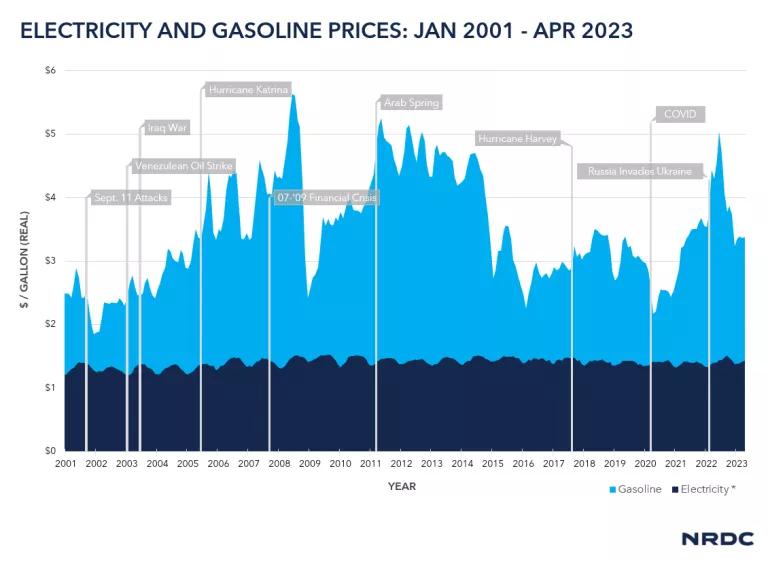Fight Fascists & Save Money: Go Electric
Gas prices remain volatile as a result of Russia's war on Ukraine and other events beyond our control, but electricity provides reliable cost savings that do not fuel petro-dictators.
The cost of a gallon of gasoline is finally coming down after a long period of high prices that strained drivers’ pocketbooks. We’ve seen this movie before. Adjusted for inflation, gas prices were similarly high in 2006, 2008 and for a while after 2011.
The current spike followed Vladimir Putin’s unprovoked and unjustified attack on Ukraine. This is a war funded by fossil fuels: Oil and gas pays more than a third of the Russian Federation’s budget. Meanwhile, Moscow is trying to use its fossil fuel exports to hold our European allies hostage.
For U.S. consumers, one thing we can do to counter the risks from petro-states is to get off oil. This will enhance national and household energy security while depriving the corrupt leaders of those states of ill-gotten windfalls.
In the past, many of us were stuck driving gasoline-fueled vehicles; we had nowhere to turn. But now we have options. In record numbers, people are ditching the pump and going electric. They want a cleaner, cheaper and stable alternative to the highly volatile oil market and wildly fluctuating gas prices.
Charging at home is roughly the equivalent of fueling up on a dollar-a-gallon gasoline. And the average price of residential electricity, adjusted for inflation, has stayed close to the dollar-a-gallon equivalent mark for over 20 years, as depicted in the chart below, while gas prices go up and down erratically.

*Shown in $/“eGallon” or the cost of fueling a vehicle with electricity compared to a similar vehicle that runs on gasoline. Data source: Energy Information Administration, January 2023; monthly averages. (June 27, 2023: This chart was updated to include electricity and gasoline prices for early 2023.)
While gas prices fluctuate due to events over which we have no control, electricity prices are inherently more stable because electricity is produced from a diverse mix of largely domestic energy sources. Electricity prices also are more stable because the power industry is regulated. No one regulates the world oil market. No one regulates dictators.
Driving on electricity provides savings households can bank on. In fact, a recent analysis by Atlas Public Policy found it’s already less expensive to own an electric vehicle (EV) than a similar gasoline model. For example, the Ford F-150 Lightning pick-up truck will be 17 percent cheaper to own than the gas-powered F-150, even though its initial sticker price is higher. It’s also cheaper to own the Volkswagen ID.4 compared to a similar SUV and a Chevy Bolt compared to a Toyota Corolla, Atlas found.
Cost savings and price stability are reasons enough to abandon the gas pump. But electric vehicles are also the cleanest vehicles on the road, emitting about a third as much climate pollution as the average gas-powered vehicle (accounting for the production and use of both fuels), and, unlike gasoline, electricity is only getting cleaner and cleaner as renewable resources like wind and solar continue to expand.
People are already making the switch. Despite vehicle production grinding to a halt and auto purchases falling considerably at the outset of the COVID-19 pandemic, EVs sales are growing rapidly, with a 102 percent increase in 2021 compared to 2020. The final quarter of 2021 was the highest quarter ever for EV sales and December 2021 saw a record for any month. In Q4 2021, around 6 percent of all passenger vehicle sales were EVs. While electric vehicles make sense for our pocketbooks now, the economics and choices in vehicle types and models are only getting better.
There are currently 57 plug-in (pure battery electric or plug-in hybrid) EV models available for purchase in the U.S. and many more are poised to reach the market over the coming years in every vehicle segment. Nearly 200,000 people have pre-ordered the Ford F-150 Lightning pickup, and in Q4 2021, two new entrants, Rivian and Lucid began delivering vehicles.
Before federal and state incentives, there are already more than a dozen EVs with a sticker price that's lower than the average new vehicle purchase price and there are EVs in every major segment (sedan, SUV, and pickup) that offer a lower total cost of ownership. And Congress is currently considering tax incentives that would make many more EV models cheaper than comparable gasoline vehicles up-front.
The up-front cost of EVs is expected to fall further with advances in battery technology and an expansion of domestic manufacturing. In December 2020, Bloomberg New Energy Finance reported that average battery prices declined by more than 90 percent from 2010 levels and now average $135 per kilowatt hour.
Such drastic reductions in battery costs are making EVs of various types and sizes cost-effective more quickly than was previously anticipated. New models are coming in the medium- and heavy-duty vehicle market with major manufacturers, including Volvo, Mack, Daimler, Peterbilt, and Ford introducing new electric vans and commercial trucks. In Q4 2021, Nikola delivered the first two electric semis with 350 miles of range.
It’s time to get off the oil price rollercoaster. Drivers have been held hostage to the whims of petro-dictators for too long. The surest way to not face a shock at the pump is to never have to use one.


